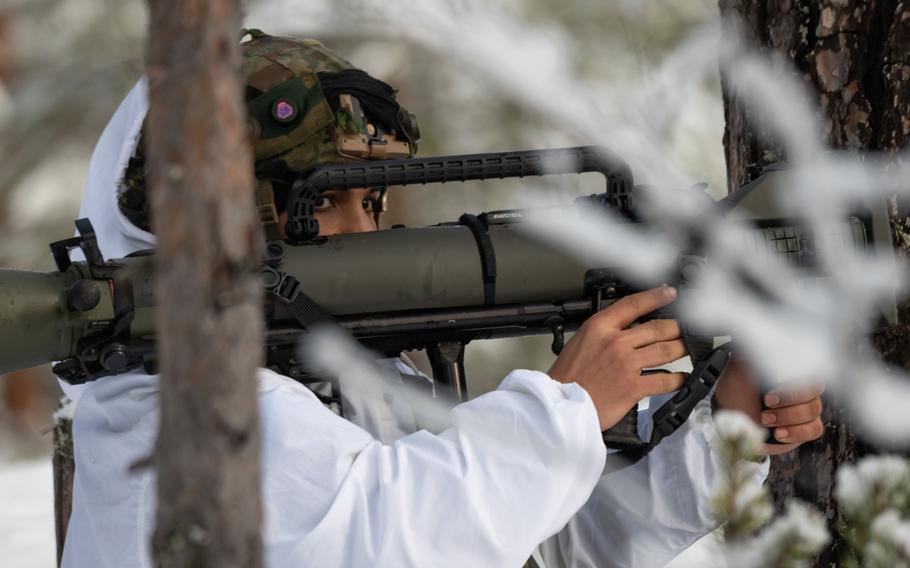
A soldier with the Alaska-based 11th Airborne Division looks for enemy activity Feb. 27, 2025, during a mock battle in Sodankylä, Finland, that was part of the Arctic Forge military exercise. (Phillip Walter Wellman/Stars and Stripes)
As president of the United States, Joe Biden kept using a peculiar phrase that showed two of the many ways in which he was a foil for his successor, Donald Trump: The 46th president was a bad communicator but a good geopolitical strategist; the 47th is the opposite.
Over and over again, Biden all but gloated that Russian President Vladimir Putin wanted “the Finlandization of NATO” but instead got “the NATOization of Finland.” Finlandization and NATOization each have five syllables and mean little to ordinary Americans, who might have pictured generals and admirals spending more time in the sauna. You won’t hear such stilted oratory from Trump, who prefers punchy monosyllabic Anglo-Saxon words. As a way of communicating grand strategy to voters, Biden’s phrase failed.
But the underlying grand strategy that Biden was trying to advertise was a qualified success — one that Trump is now undoing.
The term “Finlandization” was coined by West German scholars during the Cold War. It referred to the experience of Finland, which had twice fought off the invading Soviet Union, once in the Winter War of 1939 and again as an ally of Nazi Germany between 1941 and 1944. In a bitter armistice, it ceded about 10% of its territory to Moscow and agreed to relocate the ethnic Finns living there. But it remained an independent nation.
The arrangement later called Finlandization began in 1948 with a treaty between Helsinki and Moscow. For the privilege of remaining otherwise sovereign, Finland agreed to comply with Soviet foreign policy and to eschew closer ties to NATO, the U.S. and western Europe. Kari Suomalainen, a Finnish cartoonist, later defined Finlandization as “the art of bowing to the East without mooning the West.”
Finlandization in that narrow sense was only phased out after the Cold War, in steps that the Ukrainians nowadays also dream of taking. In 1995, Finland joined the European Union. And during Biden’s term in 2023, responding to Putin’s aggression, it finally entered the NATO alliance. (Soon followed by another Nordic country long proud of its neutrality, Sweden.) Today, Finland consistently ranks as the world’s “happiest” country.
Long ago, Finlandization also acquired its more general meaning. Even though the phenomenon was possible only because Finland was too brave and strong to be defeated (but still too weak to win), the word became pejorative and referred to any situation in which a weaker country gives up part of its sovereignty to appease a stronger power.
In this sense, Finlandization typically takes the form of involuntary neutrality or non-alignment and kowtowing to the overlord. Mongolia, which both Moscow and Beijing consider a buffer state, has been described as Finlandized; so have some of the “stans” in Central Asia. Taiwan has debated whether Finlandization would be an appropriate way to hold mainland China at bay.
Putin’s original plan for Ukraine was outright conquest and subjugation. But when the brave Ukrainians, like the Finns in 1939, denied Moscow that triumph, Putin had to downshift. For him to tolerate Ukraine’s continued existence, the country would have to become a no-man’s-land, forever outside of NATO, demilitarized and bowing to the Kremlin. In short: Finlandized. He has similar visions for, say, Moldova or Georgia (outside of NATO) and even Estonia, Latvia and Lithuania (in NATO).
As the Biden administration took pains to explain, Putin’s menace extends even further. He wants to cow, and ideally dissolve, not just Ukraine but the entire Western alliance. By violating Ukraine, he has also repudiated the whole “rules-based” international order, which is based on law and the principle of national sovereignty as enshrined in the charter of the United Nations.
So when Biden said that Putin instead NATOized Finland, he was talking about more than Finland joining the alliance. He meant that Russia had failed in a larger sense, because Ukraine — with American, European and even Asian and antipodean help — was defending itself and drawing ever closer to the West. And the West, far from cowed, was more united and resolved in defending not only Ukraine but the very idea of national sovereignty.
Trump is well on the way to flipping these achievements. He has long disdained NATO, casting doubt on the mutual-defense clause at its heart and undermining its deterrent effect on Russia. He has heaped scorn on individual allies — including Denmark, whose territory in Greenland he covets — and courted Putin as a fellow strongman. He has browbeaten the Ukrainian president in the Oval Office and, in the name of negotiating peace, seems nonchalant about an armistice that would amount to Ukrainian capitulation.
Trump even seems keen to do some of his own Findlandizing. How else would one describe the kind of submission to the U.S. he has in mind for Canada to the north or Panama to the south?
Biden understood the value of alliances and international order, and Trump does not. Biden was also bad at explaining foreign threats to Americans, whereas Trump knows how to connect with many voters. And still: Even when delivered in sound bites short and catchy, a policy of abandoning your friends and the ideal of sovereignty while accommodating tyranny and aggression is terrible grand strategy.
Andreas Kluth is a Bloomberg Opinion columnist covering US diplomacy, national security and geopolitics. Previously, he was editor-in-chief of Handelsblatt Global and a writer for the Economist. This column does not necessarily reflect the opinion of the editorial board or Bloomberg LP and its owners.